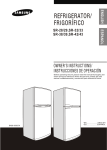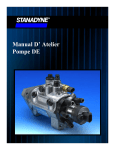Download Technovit Kunststoffe 2011
Transcript
Technovit Gebrauchsinformation Technovit 2-Komponenten-Kunststoffe ® Verwendungszweck Die schnellhärtenden Technovit Kaltpolymerisate in Form von Pulver und Flüssigkeit stellen für Ihren jeweiligen Einsatzbereich Produkte auf höchstem Qualitätsniveau dar. Hinweise für materialografische Untersuchungen: Gebrauchsinformation User Instructions Technovit ® Stand: April 2011 66022964/03 DOG/5-spr./08.07 Die Proben müssen vor dem Einbetten sauber und fettfrei sein. Zur Reinigung wird Ethanol oder Leichtbenzin empfohlen. Je nach Beschaffenheit der Probe eine dünne Schicht Technovit in die Einbettform gießen, Probe einlegen und die Einbettform bis zur gewünschten Höhe auffüllen. Bei Proben mit einfachen geometrischen Formen, diese direkt in der Einbettform positionieren und mit Technovit übergießen. Das Material in einem dünnen Strahl ausfließen lassen um evtl. eingemischte Luftblasen entweichen zu lassen. Die Materialien können nach dem Aushärten mit allen gängigen Methoden mechanisch bearbeitet werden. Insbesondere für materialografische Untersuchungsmethoden eigenen sich hierzu die Komponenten der Heraeus Kulzer/New Lam Serien. Mode d´emploi Istruzioni per l´uso Modo de empleo Anmischen Kulzer: Technovit 2060 Heraeus Kulzer GmbH Philipp-Reis-Straße 8/13 D-61273 Wehrheim/Ts. Telefon (0 60 81) 9 59-0 Telefax (0 60 81) 9 59-398 e-mail: [email protected] Internet: www.Kulzer-Technik.com Technovit 3040 Eine homogene Mischung des Kunststoffes ist Voraussetzung um die optimalen Eigenschaften zu erhalten! Flüssigkeit vorlegen, anschließend die Hälfte des Pulver hinzugeben und gründlich untermischen, den Rest des Pulvers nach und nach einstreuen. Mindestens 40 sec. mischen! Dann die Mischung ca. 10–15 sec. ruhen lassen und nochmals für 20 sec. mischen. Basismischungsverhältnis für 2Komponenten-Kunststoffe 2:1, je nach Anforderung kann das Verhältnis leicht variiert werden. Technovit 5000: Pulver im Becher vorlegen (20 g). Auf das Pulver 13 ml Flüssigkeit geben. Flüssigkeit nicht zuerst vorlegen! Mit dem Spatel gründlich durchmischen, bis alles Pulver benetzt ist und kein Flüssigkeitsspiegel stehen bleibt. Schlagende Bewegungen vermeiden, damit keine Luftblasen eingerührt werden. Vor dem Ausgießen Anrührgefäß kurz und kräftig aufstoßen, damit evtl. eingerührte Luft entweichen kann. Für das Anrühren von Technovit sind Hartpapierbecher und Holzspatel erforderlich. Die bei der Aushärtung freiwerdende Wärmemenge kann zu Porenbildung führen. Daher sollte nie mehr als ca. 30 g Teig (z. B. 20 g Pulver mit 10 g Flüssigkeit) angemischt werden. Es empfiehlt sich die entstehende Wärme durch Kühlen, z. B. mit Hilfe von Wasser, abzuleiten, um somit die Bildung von Poren zu vermindern bzw. zu vermeiden. Technovit 4002 Technovit 4004 User Instructions Technovit 2-Component Resins Größere Prüfkörper werden zweckmäßigerweise in mehreren Schichten aufgebaut. Dabei ist zu beachten, dass die nächste Schicht erst aufgetragen wird, nachdem die vorhergehende Schicht ausgehärtet ist. Für eine absolut blasenfreie Polymerisation empfehlen wir die Verwendung des Technomat Drucktopfes! Aufbewahrungshinweise Behältnisse stets geschlossen aufbewahren. Nicht über Raumtemperatur lagern. Nach Ablauf des Verfalldatums sollte das Material nicht mehr verwendet werden. Nicht in die Hände von Kindern gelangen lassen. Gefahrenhinweise R11 R20/21/22 R33 R36/37/38 R43 Leichtentzündlich. Gesundheitsschädlich beim Einatmen, Verschlucken und Berührung mit der Haut. Gefahr kumulativer Wirkungen. Reizt die Augen, die Atmungsorgane und die Haut. Sensibilisierung durch Hautkontakt möglich. Behälter an einem gut gelüfteten Ort aufbewahren. Von Zündquellen fernhalten – Nicht rauchen. Dämpfe nicht einatmen. Berührung mit der Haut vermeiden. Bei Berührung mit den Augen sofort gründlich mit Wasser abspülen und Arzt konsultieren. Maßnahmen gegen elektrostatische Aufladungen treffen. Bei der Arbeit geeignete Schutzhandschuhe und Schutzkleidung tragen. Zum Löschen Sand, Kohlendioxid oder Pulverlöschmittel, kein Wasser verwenden. Dieses Produkt und sein Behälter sind als gefährlicher Abfall zu entsorgen. S16 S23 S24 S26 S33 S36/37 S43 S60 Advice for materialographic testings: The specimen must be clean and free of grease before embedding. For cleaning ethanole or benzine is recommended. Depending on the specimen pour a thin layer of Technovit resin into the embedding mould first. Then put in the specimen and fill up the mould until the margin. Easy shaped specimen can be placed onto the bottom of the embedding mould and doused with Technovit resin directly. Let flow out the resin in a thin stream to allow airbubbles to pass off. Polymerized resins can be treated with all usual mechanical methods. Especial for materialographic applications the grinding and polishing products from the Heraeus Kulzer NEW LAM series achieve best results. Danger advice R11 R20/21/22 R33 R36/37/38 R43 A homogeneous mixture of the resin is the precondition to achieve optimal properties! Place liquid, then put in the half of the powder and mix thoroughly. Add the 2nd half of powder after and after and mix for 40 seconds. Let the dough set down for 10–15 seconds and then stir again for at least 20 seconds. Basic mixing ratio for 2-component-resins 2:1; ratio can be varied according to the requirements. Technovit 5000: Place powder in a jar (20 g). Add liquid (13 ml). Do not place liquid first! Stir toroughtly with a spatula until the powder is completely soaked with the liquid. Avoid beating movenment to include airbubbled in the resin dough. A few hard taps on the worktable will help to escape air out of the resin. For mixing Technovit hardpaper cups and wooden spatulas are recommended. The heat caused by polymerization can my lead to formation of pores. To avoid excess heat do not mix more than 30 g of dough (20 g powder/10 g liquid). Carry off heat by cooling (in a vessel with cold water) is recommended Larger specimen has to be prepared in several layers. Please be sure, that each layer is complete polyermized before applying the next one. For absolutely bubble free embeddings, use the Technomat pressure pot Highly flammable. Harmful by inhalation, if swallowed and in contact with skin. Danger of cumulative effects. Irritating to eyes, respiratory system and skin. May cause sensitization by skin contact. Safety advice S9 S16 S23 S24 S26 S33 Mixing Sicherheitsratschläge S9 The fast and coldcuring Technovit resins in form of powder and liquid are state of the art in their field of application. S36/37 S43 S60 Keep container in a wellventilated place. Keep away from sources of ignition – No smoking. Do not breathe gas/ fumes/vapour/spray. Avoid contact with skin. In case of contact with eyes, rinse immediately with plenty of water and seek medical advice. Take precautionary measures against static discharges. Wear suitable protective clothing and gloves. In case of fire, use sand, carbon dioxid or powder extinguishing agent, never use water! This material and its container must be disposed of as hazardous waste. Storage advice Keep vessels always closed. Not not store above room temperature. After expiry date the materials should not be used anymore. Keep away from reach of children. Technovit 4006/SE Technovit 4071 Technovit 5000 Technovit 5071 grün/green braun/brown grün-transparent/ green-transparent Schliffeinbettung/ Embedding Schliffeinbettung, elektrisch leitend/ Embedding electrical conductive Oberflächenabdrücke für REM/ Surface impression for SEM 2:1 20 g : 13 ml 2:1 1–2 1 2 5–7 7–12 8–10 Farbe/Color schwarz/black gelb/yellow o. schwarz/black weiß/white grau/grey transparent/clear high clear Verwendungszweck/Area of application Kunststoff für Modellbau/ Universal resin Abdrucknahme für Schliffeinbettung, Schliffeinbettung, Spaltfrei/ Oberflächenprüfung/ transparent/ Embedding – gap free Modelling and Impression Embedding – transparent Schliffeinbettung, transparent/ Embedding – transparent Basis-Anmischverhältnis Pulver : Flüssigkeit*/Basic-Mixing ratio powder : liquid* 2:1 2:1 2:1 2 2 5 2:1 2:1 Verarbeitungszeit/Handling time 2–3 4 Aushärtezeit (bei 22°C)/Curing time (by 22°C) 6 8–10 12–17 9–12 9–13 Löslichkeit/Solubility nur quellbar/ will swell only nur quellbar/will swell only nicht löslich/ not soluble nur quellbar/will swell only nur quellbar/will swell only nur quellbar/will swell only nur quellbar/will swell only in Aceton Pulver enthält:/Powder contains: Dibenzoylperoxid Dibenzoylperoxid Dibenzoylperoxid – – Dibenzoylperoxid – Dibenzoylperoxid Methylmethacrylat, 1-Dodecanthiol Methylmethacrylat Methylmethacrylat, N,N-dimethyl-p-toluidin R: 11, 37/38, 43 S: 9, 16, 24, 33, 37, 43 R: 11, 37/38, 43 S: 9, 16, 24, 33, 37, 43 R: 11, 20/21/22, 33, 37/38, 43 S: 9, 16, 24, 33, 36/37, 43 Flüssigkeit enthält:/Liquid contains: Methylmethacrylat, N,N-dimethyl-p-toluidin Methylmethacrylat, N,N-dimethyl-p-toluidin R: 11, 20/21/22, 33, 37/38, 43 S: 9, 16, 24, 33, 36/37, 43 R: 11, 20/21/22, 33, 37/38, 43 S: 9, 16, 24, 33, 36/37, 43 Methylmethacrylat Styrol, Methylmethacrylat Methylmethacrylat Gefahren- und Sicherheitshinweise/Danger- and Safteyadvice R: 11, 20, 36/37/38, 43 S: 9, 16, 23, 24, 26, 37 * Detaillierte Informationen über unsere Produkte finden Sie unter www.technovit.de. * For more information klick on our website www.technovit.de. * Pour plus de renseignements, visiter notre site Internet www.technovit.de. * Informazioni in merito sono disponibili all’indirizzo Internet www.technovit.de. * Informaciones al respecto las encontrará en Internet bajo www.technovit.de. R: 11, 37/38, 43 S: 9, 16, 24, 33, 37, 43 R: 11, 36/37/38, 43 S: 9, 16, 23, 24, 26, 37, 60 Mode d´emploi Technovit 2-composants-résine Les polymérisats à froid à prise rapide de Technovit, sous forme de poudre et de liquide, sont des produits du plus haut niveau de qualité pour vos différentes applications. Remarques pour les analyses matérialographiques: Avant l'enrobement, les échantillons doivent être propres et exempts de graisses. Pour le nettoyage, il est recommander d'utiliser de l'éthanol ou du benzène léger. Selon la nature de l'échantillon, couler une couche mince de Technovit dans le moule à enrober, poser l'échantillon et remplir le moule à enrober à la hauteur souhaitée. Pour les échantillons de formes géométriques simples, les positionner directement dans le moule à enrober et les couvrir de Technovit. Laisser la matière couler d'un jet fin pour laisser s'échapper les bulles d'air éventuellement contenues. Après le durcissement complet, il est possible de façonner les matières mécaniquement à l'aide de toutes les méthodes habituelles. Les composants des séries Heraeus Kulzer/New Lam conviennent particulièrement pour les analyses effectuées selon les méthodes matérialographiques. empêcher la formation de pores. Les éprouvettes plus grandes doivent être préparées en coulant plusieurs couches. Faire attention à couler une nouvelle couche seulement quand la couche précédente est entièrement durcie. Pour obtenir une polymérisation entièrement exempte de bulles, nous recommandons l'utilisation de l'autoclave Technomat! Remarques concernant le stockage Pendant le stockage, les récipients doivent toujours être fermés. Ne pas stocker à une température dépassant la température ambiante normale. Le matériel ne doit plus être utilisé après l'expiration de la date de conservation. Tenir éloigné des enfants. Conseils de sécurité R11 R20/21/22 R33 R36/37/38 R43 Mixage La condition nécessaire pour pouvoir conserver les propriétés optimales est que le mélange de résine est homogène! Verser d'abord le liquide, ajouter ensuite la moitié de la poudre et mélanger soigneusement, saupoudrer peu à peu le reste de la poudre. Mélanger pendant au moins 40 sec! Ensuite, laisser le mélange reposer env. 10–15 sec. et mélanger de nouveau pendant 20 sec. Le rapport du mélange de base pour les plastiques à 2 composants est 2:1, ce rapport peut varier légèrement selon les exigences. Technovit 5000: Mettre la poudre dans le gobelet (20g). Verser 13 ml de liquide sur la poudre. Ne pas verser le liquide en premier! À l'aide de la spatule, mélanger soigneusement jusqu'à ce que la poudre soit entièrement mouillée et qu'il ne reste pas de liquide en surface. Éviter des mouvements de battement pour empêcher la formation de bulles d'air. Avant le coulage, taper rapidement et fortement sur le récipient de malaxage pour chasser l'air éventuellement contenu. Pour mélanger Technovit, il faut utiliser des gobelets en carton et des spatules en bois. La chaleur qui se libère lors du durcissement peut entraîner la formation de pores. Pour cela, il ne faut pas préparer plus de 30 g de pâte (p.ex. 20 g de poudre avec 10 g de liquide). Il est recommandé d'évacuer la chaleur qui se forme en refroidissant, p.ex. à l'aide d'eau, pour réduire ou Unsere anwendungstechnische Beratung in Wort, Schrift und durch Versuche erfolgt nach bestem Wissen, gilt jedoch nur als unverbindlicher Hinweis, auch in bezug auf etwaige Schutzrechte Dritter, und befreit Sie nicht von der eigenen Prüfung der von uns gelieferten Produkte auf ihre Eignung für die beabsichtigten Verfahren und Zwecke. Anwendung, Verwendung und Verarbeitung der Produkte erfolgen außerhalb unserer Kontrollmöglichkeiten und liegen daher ausschließlich in ihrem Verantwortungsbereich. Selbstverständlich gewährleisten wir die einwandfreie Qualität unserer Produkte nach Maßgabe unserer Allgemeinen Verkaufs- und Lieferbedingungen. Facilement inflammable. Nocif par inhalation, par contact avec la peau et par ingestion. Danger d'effets cumulatifs. Irritant pour les yeux, les voies respiratoires et la peau. Peut entraîner une sensibilisation par contact avec la peau. Indications de danger S9 S16 S24 S26 S33 S36/37 S43 S60 Conserver le récipient dans un endroit bien ventilé. Conserver à l'écart de toute flamme ou source d'étincelles — Ne pas fumer. Éviter le contact avec la peau. En cas de contact avec les yeux, laver immédiatement et abondamment avec de l'eau Éviter l'accumulation de charges électrostatiques. Porter un vêtement de protection et des gants appropriés. En cas d'incendie, utiliser du sable, du dioxyde de carbone ou un agent d'extinction à poudres inertes. Ne jamais utiliser d'eau. Éliminer le produit et son récipient comme un déchet dangereux. Our technical advice, whether verbal, in writing or by way of trials, is given in good faith but without warranty, and this also applies where proprietary rights of third parties are involved. It does not release you from the obliga tion to test the products supplied by us as and to their suitabiliy for the intended processes and uses. The application, use and processing of the products are beyond our control, and therefore, entirely your own responsibility. Should, in spite of this, liabilty be established for any damage, it will be limited to the value of the goods delivered by us and used by you. We will, of course, provide consistent quality of our products within the scope of our General Conditions of Sale and Delivery. Istruzioni per l´uso Technovit 2-componenti-resina I composti polimerizzati a freddo ad indurimento rapido Technovit sotto forma di polvere e liquido rappresentano dei prodotti di altissima qualità nel loro rispettivo campo di impiego. Avvertenze per esami materialografici: Prima di essere incassati è necessario che i campioni siano puliti e privi di grasso. Per la pulizia si consiglia di impiegare dell’etanolo o benzina leggera. In base alla qualità del campione, versare nella cassaforma uno strato sottile di Technovit, introdurre il campione e riempire la cassaforma fino all’altezza desiderata. Nel caso di campioni con semplici forme geometriche, posizionarli direttamente nella cassaforma e cospargerle di Technovit. Far defluire il materiale con un getto sottile per far fuoriuscire eventuali bolle d’aria presenti. Dopo essere induriti, i materiali possono essere trattati meccanicamente con tutti i metodi comunemente in uso. In particolare per i metodi di analisi materialografici si consiglia l’impiego dei componenti della serie Heraeus Kulzer/New Lam. cessario accertarsi che lo strato susseguente venga applicato solo dopo che lo strato precedente si sia indurito. Per una polimerizzazione assolutamente priva di bolle consigliamo l’utilizzo della pentola a pressione Technomat! Avvertenze sulla conservazione Conservare i contenitori sempre chiusi. Non conservare ad una temperatura superiore a quella della temperatura ambiente. Allo scadere della data di scadenza è necessario che il materiale non venga più utilizzato. Tenere lontano dalla portata dei bambini. Normi di sicurezza R11 R20/21/22 R33 R36/37/38 R43 Mescolatura Facilmente infiammabile. Nocivo per inalazione, contatto con la pelle e per ingestione. Pericolo di effetti cumulativi. Irritante per gli occhi, le vie respiratorie e la pelle. Può provocare sensibilizzazione per contatto con la pelle. Una mescolatura omogenea del materiale sintetico è il presupposto per ottenere le proprietà ottimali! Predisporre il liquido, quindi aggiungere la metà della polvere e mescolare accuratamente, aggiungere di tanto in tanto il resto della polvere. Mescolare per almeno 40 sec.! Far riposare la mescolatura per ca. 10–15 sec. e mescolare quindi per altri 20 sec. Rapporto di mescolatura di base per materiali sintetici a 2 componenti 2:1, il rapporto può variare leggermente in base alle esigenze Technovit 5000: Predisporre la polvere nel bicchiere (20 g). Aggiungere alla polvere 13 ml di liquido. Non versare prima il liquido! Mescolare accuratamente con la spatola fino a quando tutta la polvere si sia bagnata e non sia presente alcun specchio di liquido. Evitare movimenti a percussione per non creare bolle d’aria. Prima della colata battere brevemente e forte sul recipiente per la mescolatura affinché l’aria presente possa fuoriuscire. Per la mescolatura di Technovit è necessario l’impiego di bicchieri di carta resistenti ed una spatola di legno. La quantità di calore sprigionata durante l’indurimento può comportare la formazione di pori. Per questo motivo è necessario che non venga mischiato mai un impasto superiore a ca. 30 g (ad es. 20 g di polvere con 10 g di liquido). Si consiglia di deviare il calore sprigionato con un’operazione di raffreddamento, ad es. utilizzando dell’acqua, per evitare o prevenire la formazione di pori. I corpi di controllo più grandi vengono strutturati opportunatamente in diversi strati. A tal fine è ne- Normi di conservazione Notre consultation sur la manière d’application, sous forme orale, écrite et par des essais est effectuée au mieux de nos connaissances, mais n’est valable cependant que comme indication n’entraînant aucune obligation, de même par rapport à des droits de protection éventuels de tierces personnes, et ne vous libère pas de votre propre vérification des produits livrés par nous quant à leur qualification pour les procédés et objectifs envisagés. L’application, l’utilisation et le traitement des produits sont effectués en dehors de nos possibilités de contrôle et sont donc exclusivement du ressort de vos responsabilités. Bien entendu, nous garantissons la qualité irréprochable de nos produits en conformité avec nos conditions générales de vente et de livraison. La nostra consulenza in merito alle tecniche di applicazione sia verbale che scritta e sperimentale si basa sullo stato della scienza, tuttavia vale solo come indicazione non vincolante, anche in riferimento ad eventuali diritti di terzi e non vi esonera dall’effettuare prove in proprio dei prodotti da noi forniti onde appurarne l’idoneità all’uso ed ai processi previsti. L’applicazione, l’uso e la lavorazione dei prodotti avviene al di lá delle nostre possibilità di controllo e rientra pertanto solo ed esclusivamente nella vostra responsabilità. Garantiamo una qualità ineccepibile dei nostri prodotti in conformità alle nostre Condizioni generali di vendita e di fornitura. S9 S16 S24 S26 S33 S36/37 S43 S60 Conservare il recipiente in luogo ben ventilato. Conservare lontano da fiamme e scintille — Non fumare. Evitare il contatto con la pelle. In caso di contatto con gli occhi, lavare immediatamente e abbondantemente con acqua e consultare un medico. Evitare l'accumulo di cariche elettrostatiche. Usare indumenti protettivi e guanti adatti. In caso di incendio usare sabbia, anidride carbonica o materiale antincendio in polvere. Non usare acqua. Questo materiale e il suo contenitore devono essere smaltiti come rifiuti pericolosi. Modo de empleo Technovit 2-componentes-resina Los polímetros de curado rápido en frío Technovit en forma de polvo y líquido, representan para su área de aplicación correspondiente, productos del mayor nivel de calidad. Indicaciones para estudios materialográficos: Antes de ser encapsuladas, las muestras deben estar limpias y libres de grasa. Para la limpieza se recomienda ethanol o bencina ligera. Según la calidad de la muestra colar una capa fina de Technovit dentro del molde de encapsulado, colocar la muestra y rellenar el molde de encapsulado hasta la altura deseada. En muestras con formas geométricas sencillas, posicionar estas directamente en el molde de encapsulado y cubrirlas con Technovit. Dejar fluir el material con un chorro fino para permitir el desprendimiento de eventuales burbujas de aire que puedan haberse mezclado. Tras el curado, los materiales pueden ser mecanizados con todos los métodos habituales. Los componentes de Heraeus Kulzer/New Lam Serie se adaptan especialmente para métodos de estudio materialográfico. Mezclado ¡Una mezcla homogénea del material sintético es una condición previa para mantener las óptimas propiedades! Colocar primero el líquido, a continuación adicionar la mitad del polvo y agitar intensamente, a continuación dispersar lentamente el resto de polvo. ¡Como mínimo mezclar 40 seg! A continuación dejar reposar la mezcla aprox. 10–15 seg. y mezclar nuevamente durante 20 seg. Relación de mezcla básica para materiales sintéticos de 2 componentes 2:1, la relación puede variar ligeramente de acuerdo a los requerimientos. Technovit 5000: Colocar primero el polvo en la copa (20 g). Sobre el polvo añadir 13 ml de líquido. ¡No colocar primero el líquido! Mezclar intensamente con la espátula, hasta que todo el polvo se haya humectado y no permanezca ningún espejo de líquido. Evitar movimiento de batido, para que no se introduzcan burbujas de aire. Antes de colar golpear breve y vigorosamente el recipiente de mezclado hacia arriba, para que pueda desprenderse aire eventualmente atrapado durante la mezcla. Para el mezclado de Technovit se requieren vasos de papel duro y espátulas de madera. La cantidad de calor desprendido durante le curado puede conducir a la formación de poros. Por esta razón no debe mezclarse más de aprox. 30 g de masa (p.ej. 20 g de polvo con 10 g de líquido). Se recomienda derivar el calor generado mediante enfriamiento, p.ej. con ayuda de agua, para reducir o bien evitar de esta manera la formación de poros. Nuestra asesoría de aplicaciones técnicas en base a palabras, escritos y mediante ensayos se lleva a cabo conforme a nuestro leal saber, sin embargo, sólo es valida a manera de recomendación sin ningún compromiso, incluso con respecto a eventuales derechos de protección de terceros, y no le exonera a usted de comprobar la idoneidad de los productos suministrados por nosotros para los procedimientos y fines pretendidos. Aplicación, uso y manipulación de los productos están más allá de nuestras posibilidades de control, siendo, por tanto, responsabilidad exclusiva del usuario. Naturalmente, garantizamos la impecable calidad de nuestros productos de acuerdo a nuestras Condiciones de Venta y Suministro. Probetas mayores se estructuran convenientemente en varias capas. En este caso se debe observar, que la siguiente capa solamente sea aplicada, después de que la capa anterior se haya curado. ¡Para una polimerización absolutamente exenta de burbujas recomendamos el empleo del recipiente a presión Technomat! Indicaciones de conservación Guardar siempre los envases cerrados. No almacenar a temperaturas superiores a la ambiente. Tras haber alcanzado la fecha de vencimiento, el material ya no debe ser empleado. No dejar el producto nunca al alcance de los niños. Precaución R11 R20/21/22 R33 R36/37/38 R43 Fácilmente inflamable. Nocivo por inhalación, por ingestión y en contacto con la piel. Peligro de efectos acumulativos. Irrita los ojos, la piel y las vías respiratorias. Posibilidad de sensibilización en contacto con la piel. Consejos de seguridad S9 S16 S24 S26 S33 S36/37 S43 S60 Consérvese el recipiente en lugar bien ventilado. Conservar alejado de toda llama o fuente de chispas — No fumar. Evítese el contacto con la piel. En caso de contacto con los ojos, lávense inmediata y abundantemente con agua y acúdase a un médico. Evítese la acumulación de cargas electroestáticas. Úsense indumentaria y guantes de protección adecuados. En caso de incendio, úsese arena, dióxido de carbono o producto en polvo. No usar nunca agua. Elimínense el producto y su recipiente como residuos peligrosos.


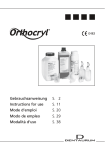
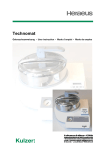

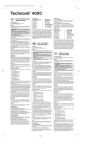
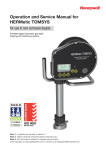


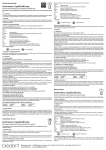

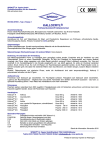
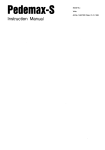
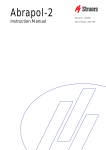
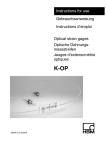


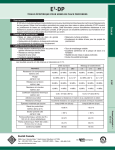
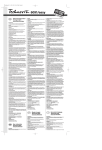
![infos sur les allergies aux matières pla[...]](http://vs1.manualzilla.com/store/data/006411260_1-7670f878c23d979b43cde6a0e0ebfb4e-150x150.png)
